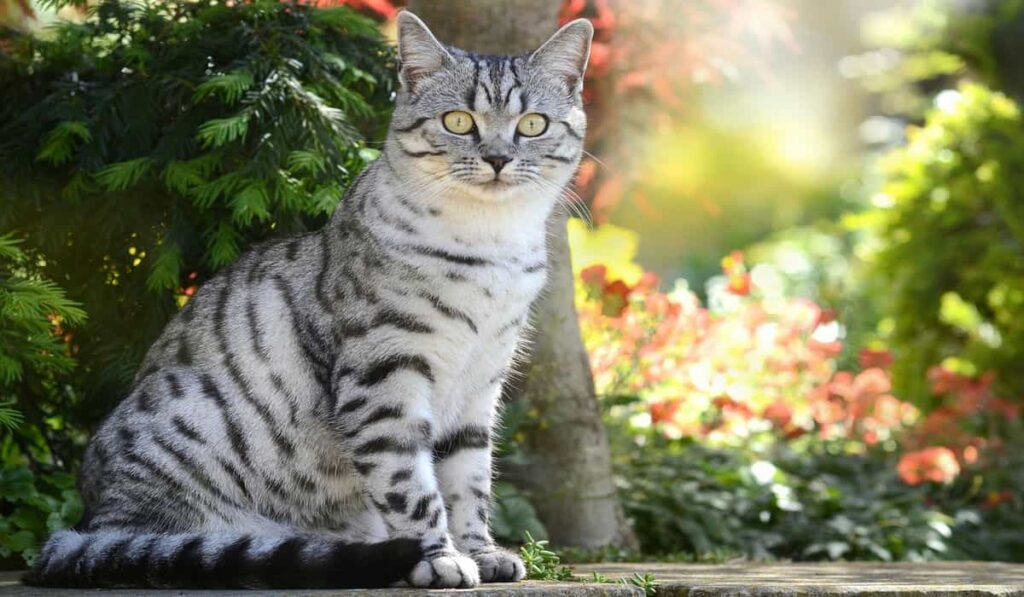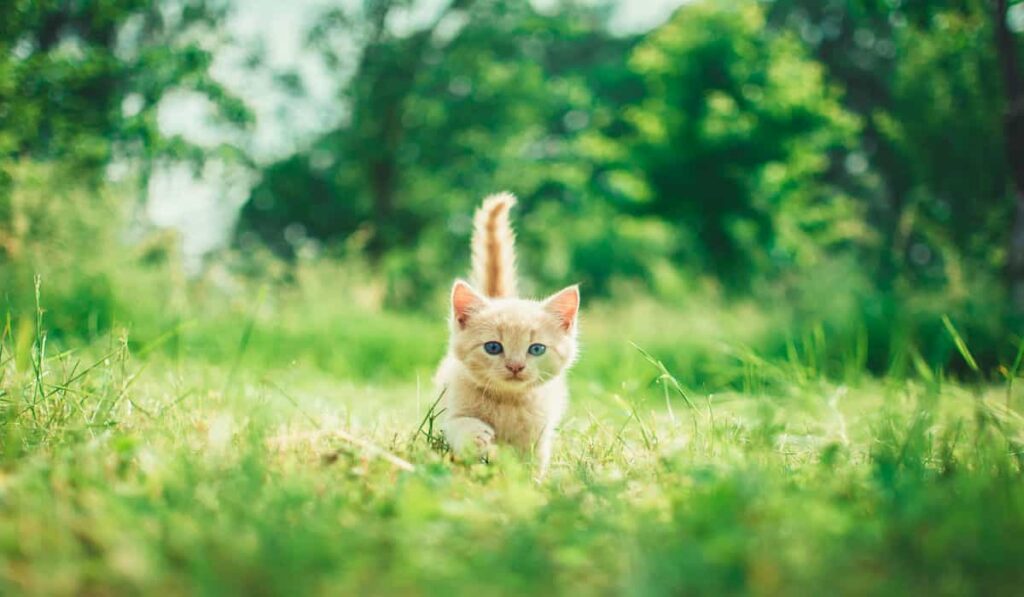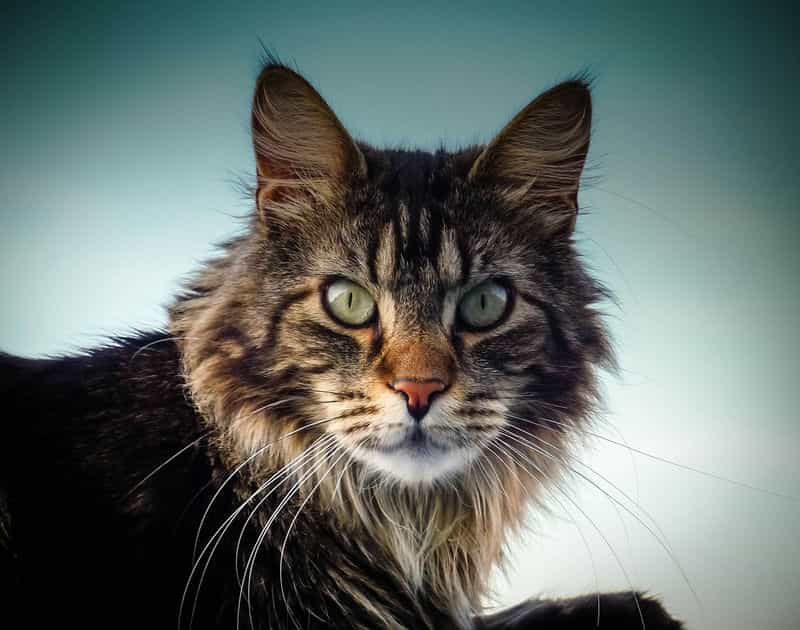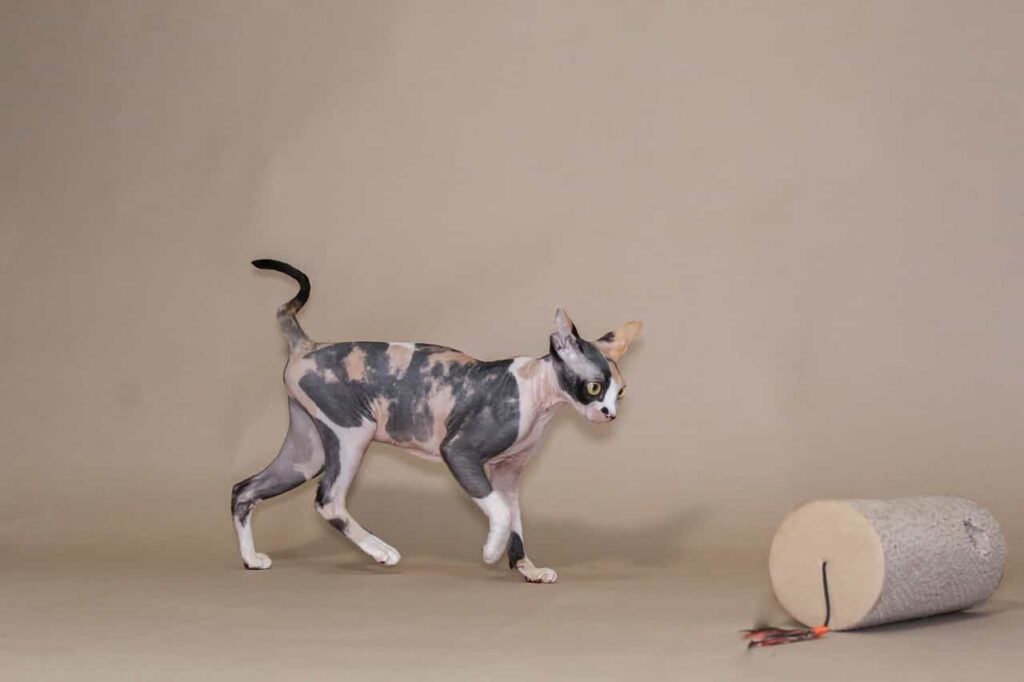Delve into the enchanting world of the Turkish Angora Cat Breed, a symbol of elegance and grace in the feline kingdom. With their luxurious, silky coats reminiscent of angora wool, these cats are a living tapestry of beauty and charm. Originating from Turkey, the Turkish Angora is celebrated for its playful and intelligent nature, capturing the hearts of cat enthusiasts worldwide.
These cats are not just a visual delight with their shimmering coats but also a marvel of personality, combining the playfulness of a Ragdoll cat with the intelligence of a Birman. The allure of the Turkish Angora goes beyond their stunning appearance; their social and affectionate demeanor makes them an ideal companion. As we explore the intricacies of the Turkish Angora Cat Breed, from their unique “Turkish angora cat personality” to the intricacies of “grooming a Turkish angora cat,” you will uncover why this breed is cherished by cat lovers globally.
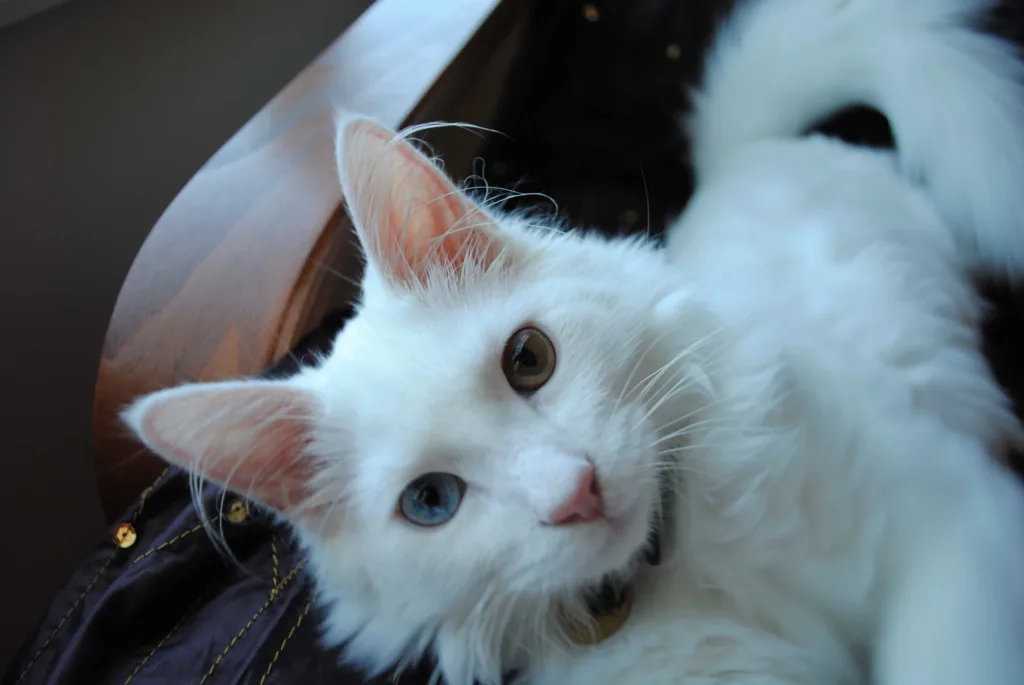

Table of contents
Turkish Angora Cat Breed
Turkish Angora Cat is a very ancient and natural breed. It is a breed of domestic cat. The breed originated in central Anatolia, at present Ankara-the capital of Turkiye. It has some other names such as- Angora and Ankara cat.
The breeds emerged in the 17th century. Turkish Angoras are known for their silky, soft, smooth, snow-white coats and Blue or Green eyes with Balerina- like bodies but have various colors and patterns in coats. They’re considered the national treasure of its homeland Turkiye.
Though the breed originated in Turkiye but is popular all over the world including the USA and the United Kingdom. It is called the Ballerina for its gracefulness.
Breed specialty of Turkish Angora Cat
Other names:
Angora, Ankara cat
Personality:
Playful, affectionate, intelligent, friendly, mischievous, packed with personality, and bossy.
Body length:
12-15 inches
Body weight:
Up to 10 pounds
Body height:
8 inches to 10 inches
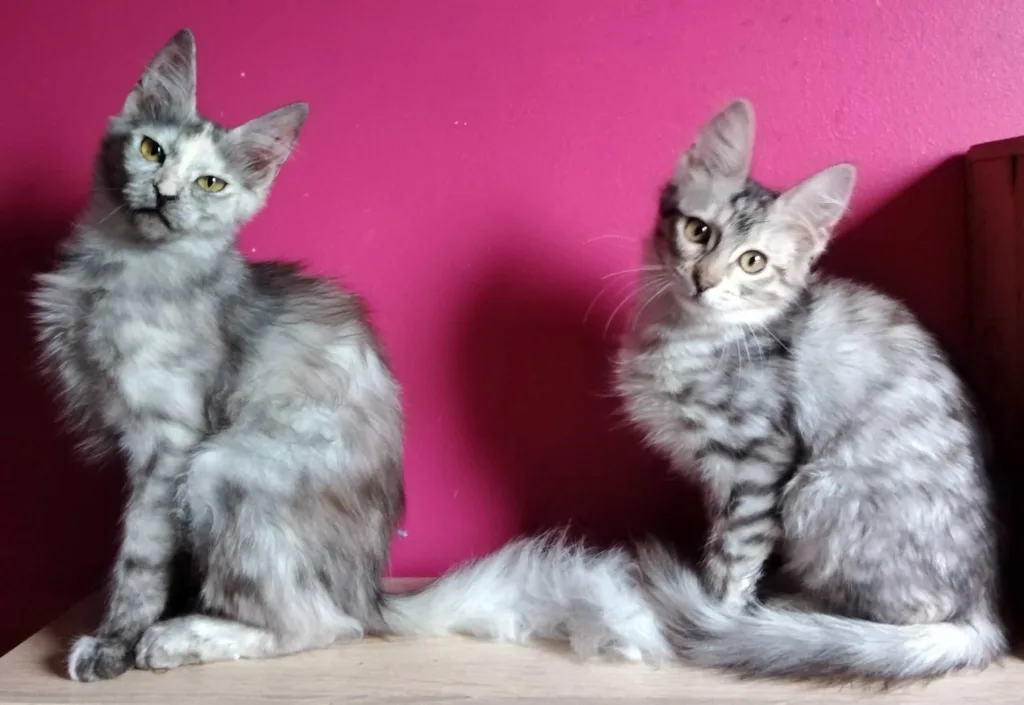

Coat length:
Longhair
Coat color:
White, Red, Cream, Black, Blue, Silver
Coat pattern:
Tortoiseshell, Calico, Dilute Calico, Blue-cream, Solid, bi-color, Tabby, and Smoked.
Eye colors:
Basically, Blue or Green but Sapphire, Emerald, Green-gold, Gold, Amber, Copper, and odd eye (2 colors in 2 eyes) are also available.
Friendliness to children and other pets:
Medium
Maintenance level:
High
Dependency:
Medium
Need for attention:
High
Shedding level:
High
Vocalizing:
Low
Lifespan:
15-18 years
Hypoallergenic:
Yes, for some people.
Origin:
Turkiye
Turkish Angora kittens
The Turkish Angora kittens are the same as their adults. They are lively, active, playful, cheeky, and intelligent. When you go to meet the kitten, please, meet the mom cat too because you’ll understand many things about the kitten to meet its mom. If possible then meet its father too.
The kitten’s mom and dad should be a much-loved pet. So, the kittens become like that. They’ll learn social skills from their pet parents at an early stage.
Choose a kitten having clear ears and eyes. If you notice that your desirable kitten is lethargic, disinterested in playing and their surroundings or have a milky discharge from its eyes and nose then don’t buy or adopt it. Kittens must be active, curious, playful, and always up for a game.
Origin of the Turkish Angora Cat breed
Turkish Angora is a naturally-occurred breed, not man-made. Like many other breeds, the Turkish Angora breed is the descendant of African Wildcats. Angora’s ancestors were first domesticated in the Fertile Crescent ( Fertile Crescent is the cradle of civilization. It is the Crescent-shaped region in Western Asia and North Africa that spans the modern-day countries of Iraq, Turkiye, Syria, Lebanon, Israel, Palestine, and also probably Egypt).
It is believed that there was a close connection between Turkish Angora and Persian cat. Charles Catton wrote a book in 1788, named ‘Animals Drawn from Nature and Engraved in Equa-tinta’. In this book, he told that Persian cat and Angora cat are the same breed, just the name is different. F. Simpson wrote in his book ‘ The Book of Cat’ that, Persian cats were developed from Turkish Angora and this development is a mutation by the British and American cat breeders. The book was published in 1903.
Moving forward, the record of Turkish Angora was written first in the late 1700s. The credit goes to the French naturalist Von Buffon. He mentioned a longhaired cat breed that originated in Turkiye. Feline geneticists believe that the cat breed was an evolution from Manul cats. The Manul cats are the first domestic cats of the Turkish people.
Well, the origin of the Turkish Angora is older than the 16th century. It is highly possible that Prophet Muhammad (S)- the founder of Islamic beliefs- had a pet cat, named Muezza was a Turkish Angora. Muhammad (S) is very fond of cats and he had so many pet cats. One day, Muezza was sleeping on Muhammads’ sleeve. It was the time to pray and Muhammad had to go. So, he didn’t want to wake up Muezza rather he cut off the sleeve and got up from the bed.
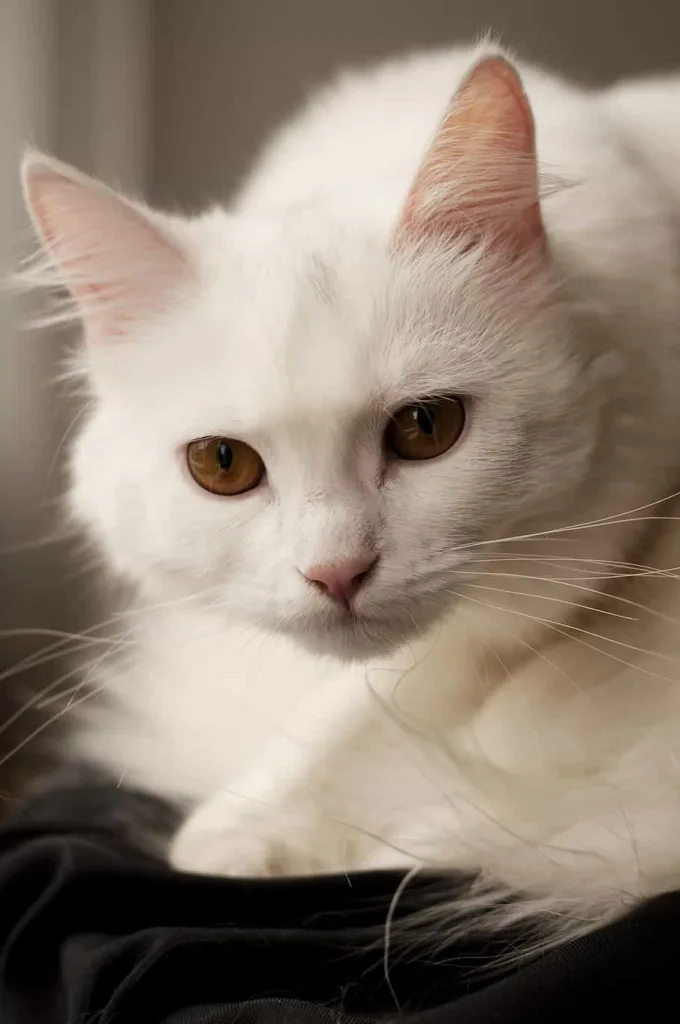

More about Turkish Angora cat origin
The Turkish Angora reached the USA by the late 1700s. The early cat fanciers and breeders blended the Turkish Angora breed with the Russian Longhair and Persian and other breeds. At that time so much interbreeding took place because Turkish Anogoras were not found outside Turkiye. Turkiye announced the cat breed as a national treasure.
Later in the 20th century, the Turkish Government and Ankara Zoo decided to preserve the breed because there is a legend that the Turkish Angora breed was the descendant of Prophet Muhammad’s pet cat Muezza. So, the Turkish Authority wanted to carry the blessings of Muhammad (S) through the cat breed.
There was an Army officer from the USA, named Colonel Walter Grant. He was stationed in Turkiye with his wife Liesa Grant. Mrs. Grant imported 2 Turkish Angora cats to the USA. These 2 Turkish Angoras came with Offspring and the interest between the breeders of the US grew rapidly.
The breed was very difficult to import at that time but more American breeders got involved in the initiative and became successful. The Turkish treasure was shared in the west once again. The Cat Fancier’s Association (CFA) recognized the Turkish Angora as a breed in 1968 and gave provincial championship status in 1970. The breed got national Championship status in 1972.
The status was only for the White Angoras at that time but in 1978, CFA granted all colors of Turkish Angora for the championship. Here one thing is to be notified that all CFA Turkish Angora cats must have a lineage that can be traced back to Turkiye. With the passing of time, the outstanding Turkish beauty achieved recognition from most cat associations worldwide.
The appearance of the Turkish Angora cat
The Turkish Angora is a medium-sized cat with a slender delicate appearance. This is according to the breed standard. The Angora cat is a long and very soft cat. They come in a White variety of colors.
Typically you’ll see them White but they can be White, Black, Blue, Cream, Red, and Silver-colored. Their coat patterns are Solid, Tabby, Smocked, Bi-color, Tortoiseshell, Calico, Dilute-Calico, and Blue-Cream.
This is an outstanding and perfect cat. If you’re looking for a small to medium-sized cat with a robust build neither delicate nor too big. The Turkish Angora has beautiful Blue eyes. There are usually anywhere from Blue to Green with also Sapphire, Emerald, Green-gold, Gold, Amber, Copper, and odd eye (2 colors in 2 eyes).
Usually, their coat is silky, smooth, and very soft. It is typically medium to long-haired. Their head is small to medium-sized with a good proportion to the body. The muzzle is wedge-shaped. The nose is medium and the chin is rounded. Their neck is medium and the male cats have more prominent jowls than the females.
The Turkish Angora cats have medium-sized and beautiful ears. The ears are situated at the corners of the head with a wide base. The legs of Angora are long and graceful. The hindlegs are curved and slightly bigger than the forelegs. The paws are soft, round, and elegant that exhibit their tufts. The Turkish Angoras have bushy, long, big tails.
Temperament and nature of the breed- Turkish Angora Cat
The Turkish Angora is a highly intelligent cat breed. These cats are incredibly social and develop a strong bonds with their families. They choose one person in the family to make the closest relationship. But these cats are loving, friendly, caring with other people, children, and also other pets and like to be around them.
They like to be independent at times. They love to play and toys around. So, if you own a Turkish angora, provide with them a lot of toys, and have fun. There should be a lot of entertainment around them as they love to play, jump, and jump all over the place.
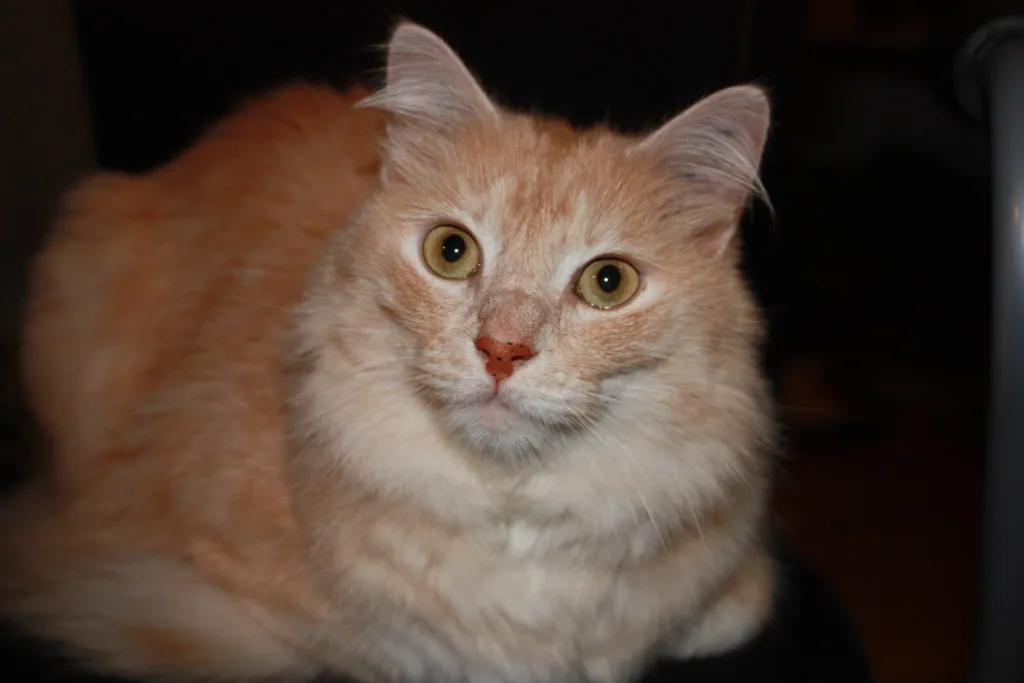

They’re not too crazy and also not too cuddly. They like to be around you and do their own things. The cats are the perfect blend of fun and cuddle. They’re packed with personality and character. Your furball friend will follow you across the house to seek a new play with you or just to see what are you doing.
The Turkish Angora breed is very fond of water. They swim in the Swimming pool and take dips in the bathtub and also give you company during your bath time. Angoras are the athletes and top performers. They love to stay at the center of the attention of all. They’re happy to share the home with other pets but they’ll take the charge of the home as the breed is bossy and territorial by nature.
The Turkish Angora is very social, loyal, and very much suitable for family life. They’re also good for childrens and other pets even dogs. But the children should be well-behaved. The Angoras are very territorial and bossy with other pets. So, it’s better that you introduce your Angora with your children and other pets in theory kittenhood.
Turkish Angora Cat Breed Caring and grooming
The Turkish Angora breed doesn’t have an undercoat. That means the grooming is fairly easy but it doesn’t mean that you can skip the grooming sessions. The one or two times coat brushing are enough to keep their coats shiny and looking good.
The furs of the cats are up and don’t mat and tangle. They continue their growth for 2 years of their growth. So, the brushing session is very important and related to your kitten’s growth. Turkish Angoras shed a lot, especially in the Spring season. So, if you don’t want the furs spread everywhere in your house that a Turkish Angora may not be the best for you.
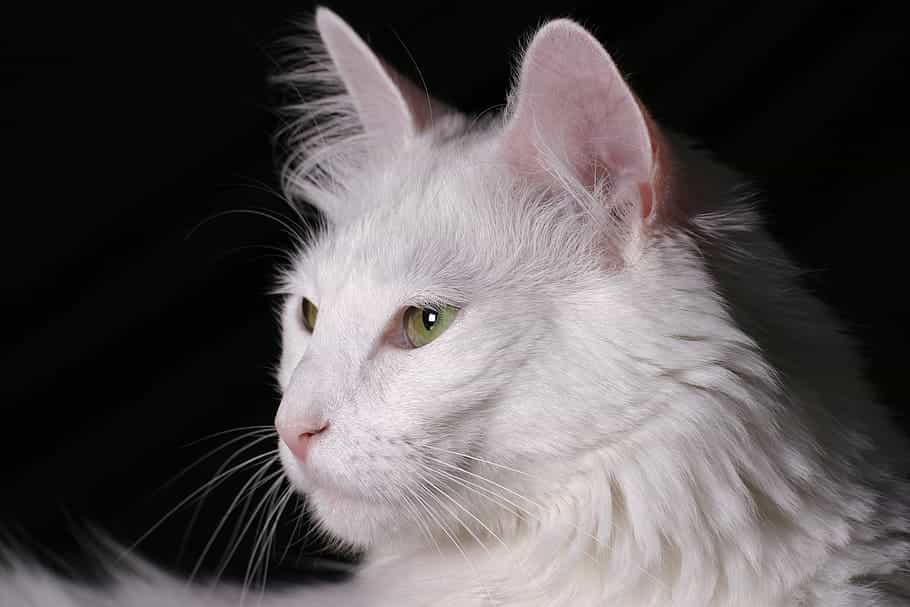

Keep their eyes and ears clean. You have to do it once a week. Brush their teeth daily and give them a bath once every week to keep them clean and shining. Provide with them a lot of toys, resting places, and scratching areas so that your pet doesn’t find your furniture as the alternative.
As the Turkish Angoras are extremely beautiful cats so there is a high chance that they may be stolen. So, don’t leave your Ballerina outside alone. As you know that your Turkish Angoras have a high energy level so plan for your cat’s exercise for 15 to 30 minutes daily. Play with your cats with fun and interactive toys so that your kitty can expend some energy.
Health and problems of the Turkish Angora cat breed
The Turkish Angora cats are prone to some health issues such as-
Hypertrophic Cardio Myopathy (HCM):
This a disease that thickens the heart walls and makes some obstacles to generating and circulate blood to the body. In a clean language- a heart disease.
Hereditary Ataxia:
The disease is inherited as an autosomal recessive. The kittens get affected and show signs from ¾ weeks. The sign is shaky movements without any movements and can’t reach adulthood.
Deafness:
The problem is common in White cats and the Turkish Angora as well. The Blue-eyed Turkish Angoras are prone to this problem. It is a genetic defect. Deafness don’t make any obstacles in the cat’s life. They can hear the traffic or any danger coming towards them. If you’re worried about the deafness your Angora then doesn’t let them out without any supervision or you may arrange an enclosed outside place for their playing time.
Shedding:
The Turkish Angora cats shed a lot during the Spring season and medium the rest of the year. So, if you can’t tolerate spreading hairs all over your house then don’t have a Turkish Angora.
Lifespan:
Turkish Angora breed lives a long life of up to 18 years. If they are healthy then life continues for up to 20 years. So, take good care of your Angora and take them to the vet for a check-up after every 6 months.
Food and nutrition tips for the Turkish Angora cats
The breed doesn’t need any special food or nutrition. Provide with them a usual high-quality feline diet. Just consider their size, age, activity level, and also gender. Overfeeding causes obesity and Diabetes. Kitten diet for Turkish Angora:
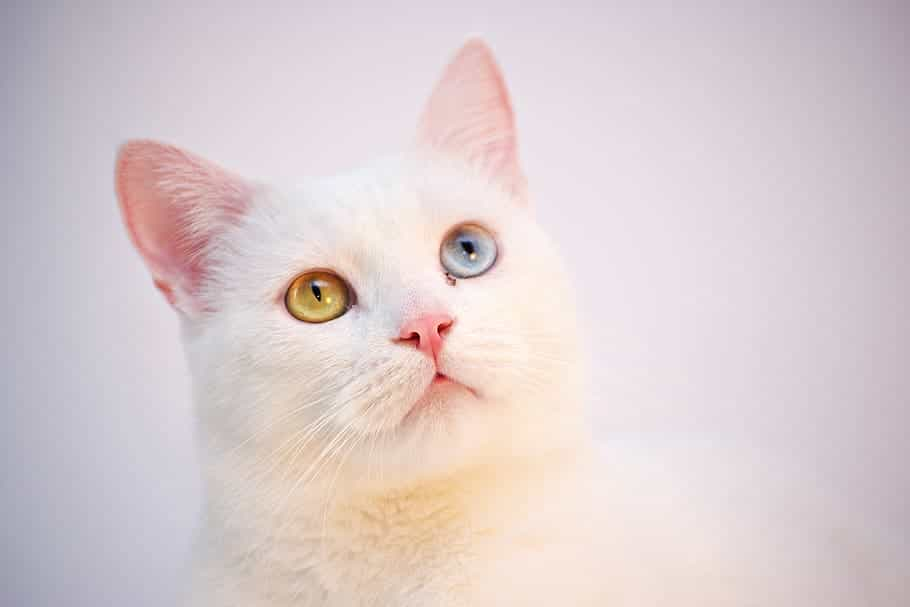

The kittens are more active and playful than the adults. So, they need more food. Provide them 3 times with an ideal measuring cup. There are so many commercial diets available in the market. So, bring kittens food for the future Ballerina.
How to identify a Turkish Angora cat?
There are 2 ways to identify a Turkish Angora:
Method-1: Identifying by their physical characteristics:
They have a beautiful, silly, and shimmery coat with longhairs. Anagrams are always long-haired, they never come with shorthairs. They have a medium, sleek, and Ballerina-typed body. Their supreme coat color is pure White but White, Red, Cream, Black, Blue, and Silver colors are also available.
They have varieties of coat patterns such as Tortoiseshell, Calico, Dilute Calico, Blue-cream, Solid, bi-color, Tabby, and Smoked. Their eye colors are basically Blue or Green but Sapphire, Emerald, Green-gold, Gold, Amber, Copper, and odd eye (2 colors in 2 eyes) are also available.
Their bodies are medium-sized with body lengths:
12-15 inches, body weight: Up to 10 pounds, and body height: 8 inches to 10 inches.
Method-2: Recognizing by behavior and characteristics
They’re very active, playful, independent, bossy, territorial, full of personality, social, intelligent, and smart cats. They are happy to share their house with children and other pets but there are 2 conditions- the childrens and other pets must be well-mannered and the house should be in charge of the Turkish Angora if there are other pets.
The cons of the Turkish Angora breed:
- The Angora cats get bored very quickly and can’t be left alone.
- They even got mischievous if get ignored.
- Very difficult to find. That means, they’re rare.
How many colors and coat–patterns Turkish Angora Cat breed have?
Well, the main color and coat pattern of Turkish Angora is pure White and Solid coats but there are so many varieties that are accepted. Those are:
Red color:
The coat color is not fully Red just Orange and Ginger color because those Angora have Orange or Ginger genes.
Cream color:
It means the diluted copy of Red, Orange, or Ginger color.
Black color:
Black means full and solid Black.
Blue color:
Not pure Blue, just Blue with a Grey glow.
Silver color:
Silver is one of the Tabby patterns.
Tortoiseshell pattern:
Just like the shell of a Tortoise.
Calico pattern:
The combination of White, Black, and Orange. White is 70% and Black is 30%.
Dilute Calico:
The faded version Calico pattern.
Blue-cream pattern:
The Diluted version of the Calico and Tortoiseshell pattern.
Solid-pattern:
Any one color in the full body. The color may be Black, White, or something else.
Bi-color pattern:
The coats consist of any 2 colors. They may be Black and White or any 2 colors.
Tabby pattern:
It is the wild marking with an ‘M’ sign on the forehead.
Smoke pattern:
Smoke means the combination of Grey and Silver color- just like the smoke.
Breed Overview of the Turkish Angora cat
The extremely beautiful, Ballerina-like body, full of personality, independent, very smart, sociable, affectionate, friendly, and intelligent- all the characteristics are appropriate for the breed- Turkish Angora. It was originated from Tukiye. They have luxurious, silky, and shiny coats
That’s why they’re named according to their homeland Turkiye. They are basically White colored and Solid-coated but they have so many varieties of colors and patterns. Blue or Green is the main color of their eyes but the eyes also have other colors.
It is a natural breed, just other breeds got mixed with it only to expand it, not for creating a new breed. Though it came from Turkiye it conquered the hearts of cat lovers worldwide. It is a medium-sized cat with body lengths,12-15 inches, body weight: Up to 10 pounds, and body height: 8 inches to 10 inches.
Deafness, Hypertrophic Cardio Myopathy (HCM), Hereditary Ataxia, and high shedding are their main health problems. The breed is very rare.
How to get A Turkish Angora Cat?
First of all, you’ve to study a lot on the internet and in pet journals before you adopt any kitty. Then you can take the following steps:
Find a breeder:
See the websites of the Cat Fancier’s association. They publish lists of reputed and trusted breeders. Find a local breeder, or go to a cat show nearby. You can purchase any pet from a breeder or cat show and you won’t be deceived from there as they’re authorized.
Try to adopt:
There are so many shelter homes across the country. See the website of Petfinder.com. You can get lists of Shelters but you have to be cautious when you’re adopting from a shelter. As Turkish Angora is a rare breed so it may not be available in shelters or rescue groups.
No owners abandon such an outstanding cat except if they fall into a problem such as death, divorce or separation, leaving the country, or financial crisis. All White cats are not Turkish Angora cats. So, you have to identify the real Turkish Angora. You can take a vet along with you while adopting an Angora cat. At last, you must have patience when you’re desiring a Turkish Angora. Don’t get deceived in a hurry!
Turkish Angora Cat Breed Characteristics
The Turkish Angora Cat Breed, renowned for its ethereal beauty and regal bearing, embodies a range of fascinating characteristics. These cats, often highlighted for their “Turkish angora cat personality,” are a blend of intelligence, playfulness, and affection. Their most striking feature is undoubtedly their silky coat, which varies in color from pure white to a tapestry of hues like blue, black, and silver. The texture of their fur, often compared to angora wool, requires regular “grooming a Turkish angora cat” to maintain its luster and prevent “Turkish angora cat shedding.”
In terms of physique, Turkish Angoras are moderately sized, with a slender and elegant build that is both strong and agile. This agility is a significant aspect of the “Turkish angora vs Persian cat” comparison, where the former is known for its playful and active nature. Turkish Angoras, much like “playful cats” in general, exhibit a lively and interactive demeanor, often engaging in spirited play and exploration. This breed’s intelligence, akin to that of “intelligent cats,” makes them quick learners and curious explorers. Their vocal nature, although not as pronounced as some “vocal cats,” adds to their charming personality.
The care for Turkish Angoras goes beyond just physical maintenance. Understanding their temperament is crucial for “Turkish angora cat care,” especially considering their high-maintenance nature. These cats thrive on attention and interaction, making them excellent family pets. For potential owners concerned about allergies, the question of “are Turkish angora cats hypoallergenic” often arises. While no cat is completely hypoallergenic, the Turkish Angora’s single-layer coat may be less triggering for some individuals. Lastly, when considering bringing this majestic breed into your home, the “Turkish angora cat price” reflects not only their rarity but also the joy and elegance they bring into a household.
Turkish Angora Cat Breed Training and Exercise
Training and exercise are integral parts of the care regimen for a Turkish Angora Cat Breed, known for their energetic and playful disposition. These cats, embodying the traits of “playful cats,” relish interactive play sessions, which not only stimulate their minds but also keep them physically fit. The “Turkish angora cat personality” is marked by a curious and intelligent nature, making them highly responsive to training. Engaging them in activities like puzzle toys, agility exercises, or even simple fetch games can be highly rewarding. When considering the “Turkish angora cat price,” it’s beneficial to invest in a variety of toys and play structures to cater to their active lifestyle.
In terms of exercise, Turkish Angoras, much like “intelligent cats,” require regular physical activity to channel their energy positively. This breed is not prone to “Turkish angora cat shedding” excessively, but regular play helps maintain their coat’s health and reduces shedding. The exercise routine for a Turkish Angora is not as intensive as some high-energy breeds, but adequate daily play is essential. This routine not only keeps them in good physical shape but also aids in preventing potential “Turkish angora cat health issues.”
When “grooming a Turkish angora cat,” incorporating play and exercise can make the experience enjoyable for both the cat and the owner. Exercise is particularly crucial when managing the health and weight of these cats, as it helps mitigate issues related to inactivity. For those interested in “Turkish angora cat adoption,” it’s important to understand that while these cats are relatively easy to care for, they do require an active lifestyle to thrive. Consequently, prospective owners should plan for daily interactive play sessions, ensuring these majestic cats live a balanced and joyful life.
Turkish Angora Cat Breed Age and Lifespan
The Turkish Angora Cat Breed is renowned not only for its elegant appearance but also for its impressive longevity. These cats typically enjoy a lifespan ranging from 15 to 18 years, with some even reaching their early twenties. This extended “Turkish angora cat lifespan” is a testament to their robust genetic makeup and the high level of care they often receive. When considering “Turkish angora cat adoption,” it’s important to be aware of this long-term commitment and ensure readiness for the journey ahead. The longevity of these cats also highlights the importance of “Turkish angora cat care,” which includes regular health check-ups, a balanced diet, and adequate exercise.
In terms of health, the “Turkish angora cat personality” of being active and playful contributes positively to their overall well-being. However, like all breeds, they have specific health considerations. Understanding these, including potential issues like “Turkish angora cat shedding” or genetic conditions, is crucial in providing them with a healthy life. Regular grooming, a key aspect of “grooming a Turkish angora cat,” helps not only in maintaining their beautiful coat but also in early detection of any health anomalies.
The “Turkish angora cat price” often reflects the breed’s rarity and the cost of maintaining their health and well-being. When comparing “Turkish angora vs Persian cat,” it’s notable that Turkish Angoras generally have fewer health issues, partly due to their less dense coat and active lifestyle. For potential owners, understanding the commitment involved in caring for these cats over their entire lifespan is key. This commitment extends beyond the initial allure of their elegant appearance and requires a deep understanding of their needs, ensuring these beautiful cats enrich our lives for as long as possible.
Turkish Angora Cat Breed Adoption Guide
Adopting a Turkish Angora Cat Breed is a rewarding journey, offering the opportunity to welcome a truly unique and elegant feline into your home. When considering “Turkish angora cat adoption,” it is essential to understand the breed’s specific needs and characteristics. These cats are known for their “Turkish angora cat personality” – intelligent, playful, and affectionate, making them ideal companions for many households. However, potential adopters should be prepared for the responsibilities that come with owning such a breed, including regular “grooming a Turkish angora cat” and addressing their active lifestyle.
The “Turkish angora cat price” can vary, but it’s important to prioritize adopting from reputable “Turkish angora cat breeders” or shelters that ensure the health and well-being of their cats. When adopting, consider the cat’s age, health status, and temperament. Younger “Turkish angora kittens” may require more training and socialization, while older cats might have established behaviors and potentially less energy. It’s also crucial to inquire about any known “Turkish angora cat health issues” to prepare for any special care or treatments they might need.
Adopting a Turkish Angora also means committing to their “Turkish angora cat lifespan,” which can extend up to 18 years or more. This long-term commitment requires consideration of various factors such as lifestyle compatibility, allergy considerations (“are Turkish angora cats hypoallergenic?”), and readiness to invest in their care and well-being. Remember, the goal of adoption is to provide a loving and permanent home for these majestic creatures. By thoroughly understanding and preparing for the needs of the Turkish Angora, adopters can ensure a harmonious and fulfilling relationship with their new feline friend.
Turkish Angora Cat Breed Socialization Tips
Socialization is a key aspect of caring for a Turkish Angora Cat Breed, contributing significantly to their well-rounded “Turkish angora cat personality.” These cats are inherently sociable, intelligent, and playful, traits that can be nurtured through proper socialization from a young age. When considering “Turkish angora cat adoption,” it’s important to start socialization early, especially if bringing a kitten into a new environment. Introducing them to various stimuli, such as different people, pets, and environments, helps in developing their confidence and adaptability.
The social nature of the Turkish Angora makes them well-suited for interactive play, which is not only enjoyable but also a vital part of their development. Owners should engage in regular play sessions, using toys that stimulate their natural instincts. This breed’s playful and active nature can be enhanced through activities that mimic hunting behaviors, such as chasing and pouncing. When thinking about “grooming a Turkish angora cat,” incorporating socialization into grooming sessions can make the process more enjoyable and less stressful for the cat.
For those concerned about “Turkish angora cat shedding,” regular brushing during socialization can help manage this while also serving as a bonding activity. The “Turkish angora cat price” reflects not just the physical attributes of these cats but also their need for emotional and social engagement. Integrating socialization into daily routines ensures that Turkish Angoras remain well-adjusted and content. Additionally, understanding their temperament and needs is crucial for a harmonious living arrangement, especially in households with other pets or children. By prioritizing socialization, owners can enjoy the full extent of the Turkish Angora’s affectionate and engaging personality.
Conclusion
In summary, the Turkish Angora Cat Breed represents a harmonious blend of grace, intelligence, and affection. From their elegant, silky coats reminiscent of angora wool to their lively and engaging “Turkish angora cat personality,” these cats are a true delight to have as companions. Prospective owners considering “Turkish angora cat adoption” should appreciate the breed’s unique characteristics, including their playful nature and social disposition. Regular “grooming a Turkish angora cat” and addressing their need for exercise and interaction are key aspects of their care. Understanding the “Turkish angora cat lifespan” emphasizes the long-term commitment required, ensuring these beautiful cats receive the love and attention they deserve throughout their lives.
The “Turkish angora cat price” reflects not only the breed’s rarity but also the joy and elegance they bring into a household. Whether comparing “Turkish angora vs Persian cat” or contemplating “Turkish angora cat shedding,” it’s clear that the Turkish Angora stands out with its unique attributes. In conclusion, welcoming a Turkish Angora into your home means embracing a journey filled with affection, activity, and the unparalleled beauty of one of the most ancient and revered cat breeds in the world.

